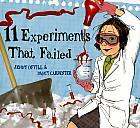 Summary: Have you ever wanted to know the answer to something you wondered about? Could an experiment help answer that question? What are the steps to conducting an experiment? Follow along with this curious girl who dresses like a scientist and conducts eleven experiments on things she has wondered about. Will a piece of bologna fly like a Frisbee? Do dogs like to be covered in glitter? She begins with the question and states her hypothesis. From there she lists what is needed for each experiment and what to do. Finally, she lists the results. Not all experiments are serious scientific discoveries. In fact, some of them can be quite humorous.
Summary: Have you ever wanted to know the answer to something you wondered about? Could an experiment help answer that question? What are the steps to conducting an experiment? Follow along with this curious girl who dresses like a scientist and conducts eleven experiments on things she has wondered about. Will a piece of bologna fly like a Frisbee? Do dogs like to be covered in glitter? She begins with the question and states her hypothesis. From there she lists what is needed for each experiment and what to do. Finally, she lists the results. Not all experiments are serious scientific discoveries. In fact, some of them can be quite humorous.
Qualitative Reading Analysis: The complexity of this text is slight to moderate. It is well organized in that each experiment takes three pages to complete. The text features and graphics are very complex. They include headings that are in a larger font and different font color. The steps for the experiments are numbered and the supplies needed and results use bullet points. The art work is quite complex as well. Photos are used for certain items such as a lawn chair, pink tutu, and pink glitter in a tube, while other things are line drawings with watercolour such as the dog laying on the lawn chair and the girl who is standing on a photo of grass while wearing the pink tutu and holding the glitter. The vocabulary knowledge will be common to most readers with the possible need to introduce words such as hypothesis and fungus.
Genre and/or Subject Area: Humor/Science
Reading Level/Interest Level: Follett RL: 2.9 / Grades K-3
CCSS Reading Standards for Literature K-5:
1. Read closely to determine what the text says explicitly and to make logical inferences from it; cite specific textual evidence when writing or speaking to support conclusions drawn from the text.
4. Interpret words and phrases as they are used in a text, including determining technical, connotative, and figurative meanings, and analyze how specific word choices shape meaning or tone.
10. Read and comprehend complex literary and informational texts independently and proficiently.
Recommendations/Curriculum Suggestions: This would be a great book to read aloud to students when introducing scientific method in science. It encourages the students to think of ideas for experiments for a possible upcoming science fair while introducing terms such as hypothesis.
Links Supporting Digital Content: Scientific Method http://www.biology4kids.com , Scientific Methods http://studyjams.scholastic.com
Bibliographic Information: Offill, J. (2011), 1 Experiments That Failed, New York: Schwartz & Wade Books